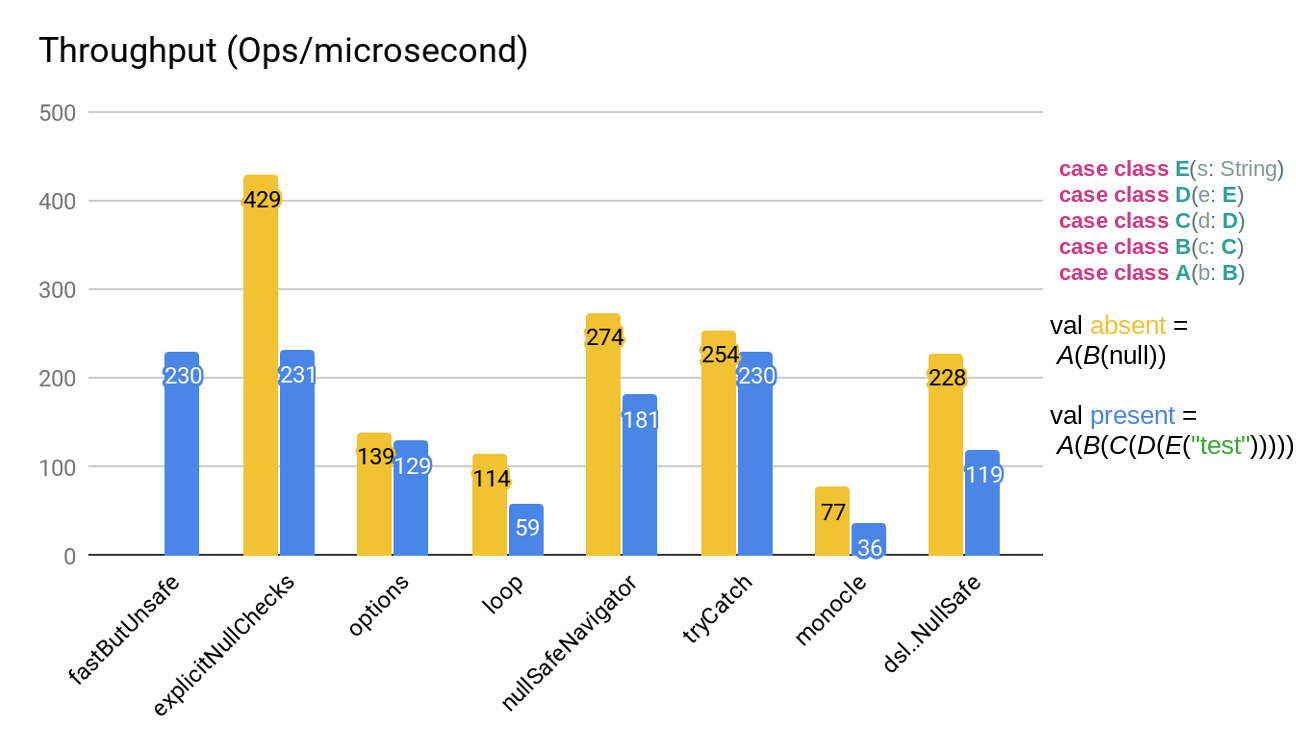Null-safety Part 2: Working With Null in Scala
So how then, given this problem, are we to try to write null-safe code in Scala? NullPointerExceptions (NPEs) occur when we try to access a field, method, or index, of an object that is actually null.
case class A(b: B)
case class B(c: C)
case object C
val a: A = null
a.b.c //Would result in an NPEMost Scala programmers would opt to wrap their code in Option in order to avoid NPEs, however sometimes you don’t have the option (pun intended) to do this. I frequently ran into this situation at my work, where we needed to pull data out of highly nested Avro classes, in some cases 6 levels deep. Avro schemas get compiled into regular Java objects, that don’t use Option. So then what, if your code is not designed around Option, is the best approach to extract deeply nested values in a null-safe way? Essentially, what is missing from Scala here is a safe navigation operator similar to Groovy or Kotlin.§
In order to find the best solution to this problem, I began by enumerating all of the possible ways that I could think of to implement null-safe access.
1. Explicit null safety
if(a != null){
val b = a.b
if(b != null){
b.c
} else null
} else nullPros: Very efficient, just comprised of null-checks
Cons: Poor readability and writability
2. Option flatmap
Option(a)
.flatMap(a => Option(a.b))
.flatMap(b => Option(b.c))Pros: Better read/writability, but still not great.
Cons: High performance overhead, object allocation + virtual method calls per level of drilldown
3. For Loop
for {
aOpt <- Option(a)
b <- Option(aOpt.b)
c <- Option(b.c)
} yield cSimilar to the approach #2, but slightly slower and worse readability.
4. Null-safe navigator extension method
implicit class nullSafe[A](val a: A) extends AnyVal {
def ?[B <: AnyRef](f: A => B): B = if (a == null) null else f(a)
}
a.?(_.b).?(_.c)Pros: Pretty readable syntax. No object allocation.
Cons: Syntax still not perfect. 1 function call per level of drilldown
5. Try Catch NPE
try { a.b.c } catch {
case _: NullPointerException => null
}Pros: Syntax could be very nice if abstracted out to a function
Cons: Harsh performance penalty in case of NPE. Could intercept other NPEs
6. Monocle Lenses
import monocle.Optional
val aGetB = Optional[A,B]{
case A(b) if b != null => Some(b)
case _ => None
}(b => { case A(_) => A(b) })
val bGetC = Optional[B,C]{
case B(c) if c != null => Some(c)
case _ => None
}(c => { case B(_) => B(c) })
val aGetC = aGetB composeOptional bGetC
aGetC.getOption(a)I didn’t really consider using lenses when I began this project, but someone asked me one time, “Why not use lenses, like in Monocle?” So I tried it out, but it didn’t succeed in either read/writability, or performance, in this use case.
7. § com.thoughtworks NullSafe DSL
So actually, when I began this project I didn’t know that this library existed. Essentially what it does is add in the missing safe navigation operator to Scala, via a compiler plugin.
import com.thoughtworks.dsl.keywords.NullSafe._
a.?.b.?.cIt has nice syntax, but it does introduce some performance overhead.
Comparing Approaches
Here are some benchmarks of the different approaches.

Data in tabular form
[info] Benchmark Mode Cnt Score Error Units
[info] Benchmarks.fastButUnsafe thrpt 20 230.157 ± 0.572 ops/us
[info] Benchmarks.explicitSafeAbsent thrpt 20 429.090 ± 0.842 ops/us
[info] Benchmarks.explicitSafePresent thrpt 20 231.400 ± 0.660 ops/us
[info] Benchmarks.optionSafeAbsent thrpt 20 139.369 ± 0.272 ops/us
[info] Benchmarks.optionSafePresent thrpt 20 129.394 ± 0.102 ops/us
[info] Benchmarks.loopSafeAbsent thrpt 20 114.330 ± 0.113 ops/us
[info] Benchmarks.loopSafePresent thrpt 20 59.513 ± 0.097 ops/us
[info] Benchmarks.nullSafeNavigatorAbsent thrpt 20 274.222 ± 0.441 ops/us
[info] Benchmarks.nullSafeNavigatorPresent thrpt 20 181.356 ± 1.538 ops/us
[info] Benchmarks.tryCatchSafeAbsent thrpt 20 254.158 ± 0.686 ops/us
[info] Benchmarks.tryCatchSafePresent thrpt 20 230.081 ± 0.659 ops/us
[info] Benchmarks.monocleOptionalAbsent thrpt 20 77.755 ± 0.800 ops/us
[info] Benchmarks.monocleOptionalPresent thrpt 20 36.446 ± 0.506 ops/us
[info] Benchmarks.nullSafeDslAbsent thrpt 30 228.660 ± 0.475 ops/us
[info] Benchmarks.nullSafeDslPresent thrpt 30 119.723 ± 0.506 ops/us
[success] Total time: 3909 s, completed Feb 24, 2019 3:03:02 PMIn order to summarize the pros and cons of each approach, let’s evaluate them based on null-safty, read/writability, and efficiency.
| Null-safe | Readable / Writable | Efficient | |
|---|---|---|---|
| Normal access |
|
|
|
| Explicit null-checks |
|
|
|
| Option flatMap |
|
||
| For loop flatMap |
|
|
|
| Null-safe navigator |
|
|
|
| Try-catch NPE |
|
|
|
| Monocle Optional (lenses) |
|
||
| thoughtworks NullSafe DSL |
|
|
|
Key: ![]() ️ = Good,
️ = Good, ![]() = Sub-optimal,
= Sub-optimal, ![]() = Bad
= Bad
After evaluating all of the options available, I wasn’t quite satisfied with any of them, so I decided to create a new way via Scala’s blackbox macros.